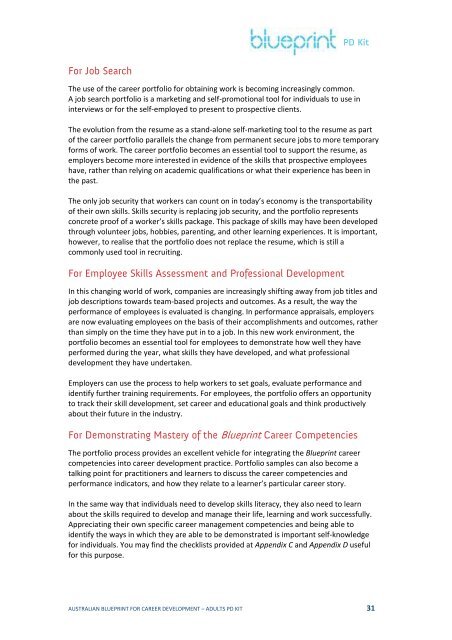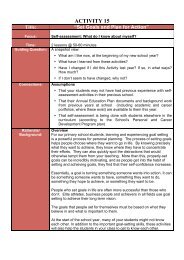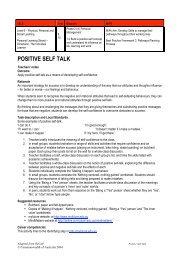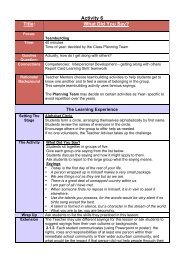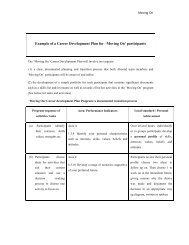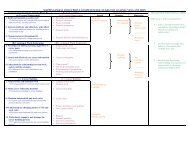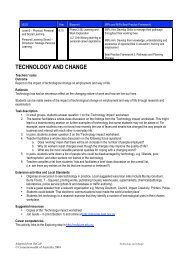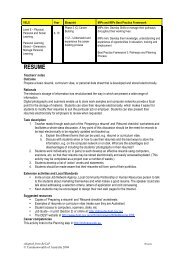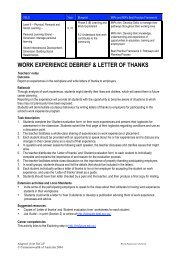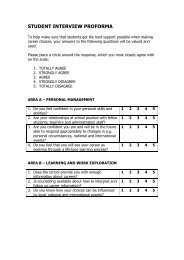Re-write of case studies - Blueprint - Australian Blueprint for Career ...
Re-write of case studies - Blueprint - Australian Blueprint for Career ...
Re-write of case studies - Blueprint - Australian Blueprint for Career ...
You also want an ePaper? Increase the reach of your titles
YUMPU automatically turns print PDFs into web optimized ePapers that Google loves.
PD Kit<br />
For Job Search<br />
The use <strong>of</strong> the career portfolio <strong>for</strong> obtaining work is becoming increasingly common.<br />
A job search portfolio is a marketing and self-promotional tool <strong>for</strong> individuals to use in<br />
interviews or <strong>for</strong> the self-employed to present to prospective clients.<br />
The evolution from the resume as a stand-alone self-marketing tool to the resume as part<br />
<strong>of</strong> the career portfolio parallels the change from permanent secure jobs to more temporary<br />
<strong>for</strong>ms <strong>of</strong> work. The career portfolio becomes an essential tool to support the resume, as<br />
employers become more interested in evidence <strong>of</strong> the skills that prospective employees<br />
have, rather than relying on academic qualifications or what their experience has been in<br />
the past.<br />
The only job security that workers can count on in today’s economy is the transportability<br />
<strong>of</strong> their own skills. Skills security is replacing job security, and the portfolio represents<br />
concrete pro<strong>of</strong> <strong>of</strong> a worker’s skills package. This package <strong>of</strong> skills may have been developed<br />
through volunteer jobs, hobbies, parenting, and other learning experiences. It is important,<br />
however, to realise that the portfolio does not replace the resume, which is still a<br />
commonly used tool in recruiting.<br />
For Employee Skills Assessment and Pr<strong>of</strong>essional Development<br />
In this changing world <strong>of</strong> work, companies are increasingly shifting away from job titles and<br />
job descriptions towards team-based projects and outcomes. As a result, the way the<br />
per<strong>for</strong>mance <strong>of</strong> employees is evaluated is changing. In per<strong>for</strong>mance appraisals, employers<br />
are now evaluating employees on the basis <strong>of</strong> their accomplishments and outcomes, rather<br />
than simply on the time they have put in to a job. In this new work environment, the<br />
portfolio becomes an essential tool <strong>for</strong> employees to demonstrate how well they have<br />
per<strong>for</strong>med during the year, what skills they have developed, and what pr<strong>of</strong>essional<br />
development they have undertaken.<br />
Employers can use the process to help workers to set goals, evaluate per<strong>for</strong>mance and<br />
identify further training requirements. For employees, the portfolio <strong>of</strong>fers an opportunity<br />
to track their skill development, set career and educational goals and think productively<br />
about their future in the industry.<br />
For Demonstrating Mastery <strong>of</strong> the <strong>Blueprint</strong> <strong>Career</strong> Competencies<br />
The portfolio process provides an excellent vehicle <strong>for</strong> integrating the <strong>Blueprint</strong> career<br />
competencies into career development practice. Portfolio samples can also become a<br />
talking point <strong>for</strong> practitioners and learners to discuss the career competencies and<br />
per<strong>for</strong>mance indicators, and how they relate to a learner’s particular career story.<br />
In the same way that individuals need to develop skills literacy, they also need to learn<br />
about the skills required to develop and manage their life, learning and work successfully.<br />
Appreciating their own specific career management competencies and being able to<br />
identify the ways in which they are able to be demonstrated is important self-knowledge<br />
<strong>for</strong> individuals. You may find the checklists provided at Appendix C and Appendix D useful<br />
<strong>for</strong> this purpose.<br />
AUSTRALIAN BLUEPRINT FOR CAREER DEVELOPMENT – ADULTS PD KIT 31


